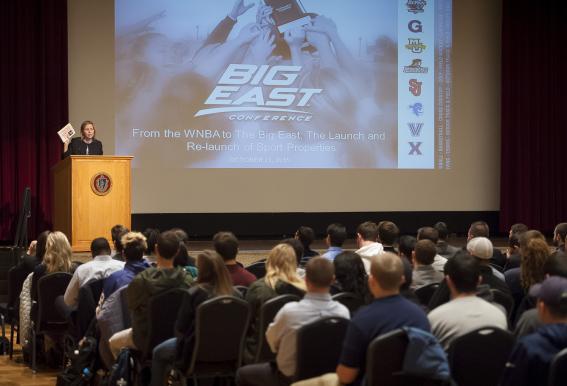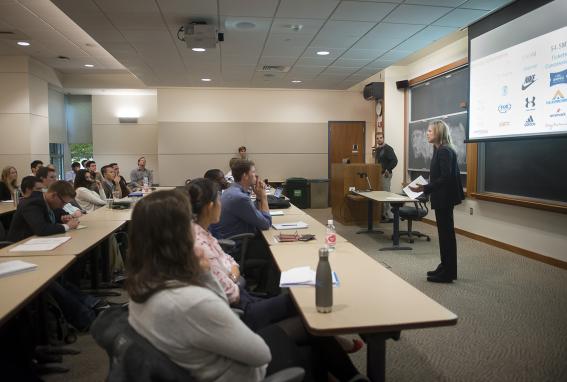Big East Commissioner is a Start-up Specialist
November 6, 2015

“I had to recreate infrastructure. I had no office, no web site, no employee benefit plans, no insurance. . . “It was exhilarating but grueling,” Ackerman continued. After considerable sweat equity which yielded a new foundation, “it’s now about being distinctive as a conference; doing right by our students. . . and solidifying our niche [which, she said, draws heavily on the Big East’s storied heritage].
During her visit to Isenberg as McCormack Executive-in Residence, Ackerman spoke in McCormack classes and met informally with students and faculty. She also recorded insights in the McCormack Sport Innovation Oral History Project with the University Archives at the UMass Amherst Libraries.

In her public lecture, “From the WNBA to the Big East: The Launch and Relaunch of Sport Properties,” Ackerman explained the strategies and learning curves accompanying both high-profile challenges. A former hoop standout at the University of Virginia and a staff attorney and executive with the NBA from 1988 to 1996, she became, with former NBA commissioner David Stern’s blessings, the WNBA’s first president, guiding its launch in 1997 and heading its day-to-day operations during its first eight seasons. That experience, she emphasized, helped her in her current reboot of the Big East.
The positive impact of Title IX, the flowering of women’s college basketball, and the gold medal performance in 1996 of the first USA women’s Olympic basketball team all paved the way for the WNBA’s successful launch, Ackerman told her UMass audience. Noting its forthcoming 20th season milestone, Ackerman described seven strategic “pillars” in the leagues gestation.
The league’s strong talent pool and marquee players like Rebecca Lobo conferred a sellable product. Its summer-based season gave it competitive breathing room, and its contracts with NBC, ESPN, and Lifetime offered national exposure. At the same time, the NBA conferred critical resources and leverage. The league’s NBA-driven launch model entrusted WNBA ownership to a group of investors and parceled out its teams as franchises. It tamed player costs by requiring each player sign separate contracts with the league. And it controlled all contracts with advertisers on national, local, and individual player domains.
Rebirth of a Conference
Turning to the Big East, Ackerman began with a backgrounder on the conference’s roots. Founded in 1979, the basketball-focused conference of mostly Catholic colleges and universities achieved legendary status from its NCAA tournament achievements and distinctive players and coaches. In 2012-2013, seven members of the conference, in pursuit of lucrative football revenues, left the Big East for the newly formed American Athletic Conference. The Big East’s seven remaining basketball-oriented members stayed on in the company of three new members: Xavier, Butler, and Creighton.
“They wanted to be basketball-centric—unbeholden to football,” emphasized Ackerman, who joined the Big East after two terms as president of USA Basketball, which oversees the U.S. men’s and women’s Olympic basketball programs. Basketball centrism is a central strategic pillar for the conference and its members, she said. Other strategic assets, she continued, include the conference’s storied history and its emphasis on academics and community service. (Nine of its ten members, she noted, have Catholic origins.) Ackerman and her conference have secured broadcast ties with Fox, and postseason tournament arrangements with Madison Square Garden.
They’ve also moved their headquarters from Providence to the Big Apple. Those assets, Ackerman emphasized, will count for more in a changing landscape of college sports with 32 Division 1 conferences and expanded access to players under a 24-7 media and social media microscope. Should “pay to play” arrangements for college athletes be the future of collegiate athletics? Not in the Big East, insisted Ackerman, which offers generous scholarships and accommodations to its varsity athletes. The bottom line, she said, is to graduate well-educated athletes. After all, “only an infinitesimal number of them make the pros.”